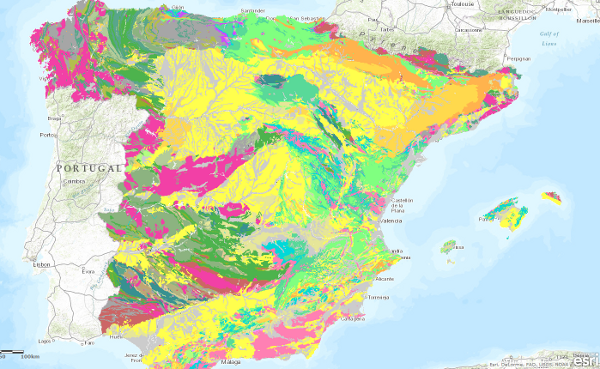infoManagementService
Type of resources
Available actions
Provided by
Years
Formats
status
Service types
-
ATOM download service of Geological Survey of Spain datasets.
-

The Neotectonic Map expresses those structural, morphological, stratigraphic and other features that show relatively recent movements (from the period considered neotectonic), as well as the type of stress to which the peninsula is subjected. Its objectives are to identify deformations from the Middle Miocene - Upper Miocene boundary to the present day. The materials have been classified into six categories, two for volcanic materials differentiated by age; and four for the rest of the materials, with four subdivisions according to age. It also includes tectonic structures, stress and deformation directions, diapiric structures and other related phenomena, all with age expression. The map contains information on the Spanish continental shelf.
-

Map showing the geographical distribution of ground movements classified into four main groups: horizontal component in continental areas, vertical component in continental areas, unstable areas linked to coastal areas and movements related to mining operations. Also included are continental areas with important erosive processes.
-

This map shows deposits dated as Plio-Pleistocene to contemporary, classified in 10 geochronological intervals and separated according to their genesis. Glacial, volcanic, karstic, aeolian, littoral, edaphic, palaeontological and prehistoric entities are included.
-

Mapa con las unidades cronolitoestratigráficas de la provincia de Alicante acompañado de fallas y estructuras de plegamiento. Forma parte de una síntesis geológica unificada de la Comunidad Valenciana.
-

The lithological map at a scale of 1:1,000,000 has been obtained by assigning the most representative lithology or lithological association to each cartographic unit on the map. It has been based on the original classification of the edited map, which has been subsequently revised, giving rise to the current classification.
-

Map showing the chronolithostratigraphic units of the area covered by the sheet separated by different types of contacts: normal or concordant, discordant, intrusive and other. The tectonic structure is represented by the cartographic traces of folds, the orientation and dip of planar and linear elements contained in the rocks, as well as by the structural relationship - through faults and thrusts - between the cartographically differentiated rock assemblages. Unique features of the igneous rocks as well as the degree of migmatisation of the metamorphic rocks are also depicted. The map is accompanied by the lithostratigraphic legend and conventional signs.
-

Hydrogeological Map of Spain classified according to aquifer type and lithogeochemical characterisation.
-

The geological age map of the units at a scale of 1:1,000,000 has been generated from the information in the chronolithostratigraphic column of the map. In all units the System has been specified, the Series has only been covered in about half of the units and the Floor is occasional. In cases where it has not been possible to establish a chronostratigraphic section, the value "undetermined" has been assigned.
-

Map with the geographical distribution of the areas where similar expansivity is assumed for the clays, which have been classified into four groups: none to low, low to moderate, moderate to high and high to very high. The different mapped units have been assigned age (4 possible) and lithology (7 different types). The map also shows the surface formations without distinction.
 Catalogo de metadatos del IGME
Catalogo de metadatos del IGME